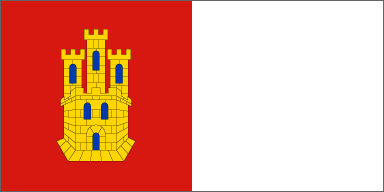La Judería de Toledo
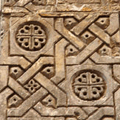 Toledo had one of the largest Jewish populations in Spain during the Middle Ages. During the 12th and 13th centuries, the Jews of Toledo recieved certain rights and freedoms in accordance with Christian law. The Judería (the old Jewish Quarter), the center of Jewish life and culture, stretches from Calle Taller del Moro as far as the city walls at the Puerta del Cambrón. Two of the city's ten synagogues still survive as they had been converted into churches - the Sinagoga del Tránsito and the Sinagoga Santa Maria la Blanca. In the Middle Ages, Jews would often
form an “aljama” headed by a rabbi named by the king. Toledo had one of the largest Jewish populations in Spain during the Middle Ages. During the 12th and 13th centuries, the Jews of Toledo recieved certain rights and freedoms in accordance with Christian law. The Judería (the old Jewish Quarter), the center of Jewish life and culture, stretches from Calle Taller del Moro as far as the city walls at the Puerta del Cambrón. Two of the city's ten synagogues still survive as they had been converted into churches - the Sinagoga del Tránsito and the Sinagoga Santa Maria la Blanca. In the Middle Ages, Jews would often
form an “aljama” headed by a rabbi named by the king. 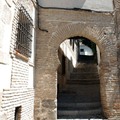 The rabbi act as the spiritiual
and political leader of the community. The Jewish community maintained its religious and cultural traditions in conformity with Christian rule. The rabbi act as the spiritiual
and political leader of the community. The Jewish community maintained its religious and cultural traditions in conformity with Christian rule.
|
El Tránsito, Synagogue in Toledo, Spain
|
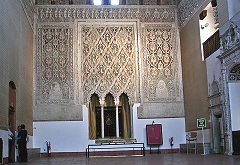
|
El Tránsito: The structure dates from the mid-fourteenth century when Shmuel Ben Meir Ha-Levi Abulafia, advisor and treasurer to King Pedro I of Castile (1350-1369), ordered the construction of a synagogue in the medieval Jewish quarter (juderia) of the city of Toledo. Dedicated in 1357, the El Tránsito Synagogue has a rectangular prayer hall (23 m by 12 m with a height of 9.5 m). To the north of the prayer hall is a separate chamber for women. 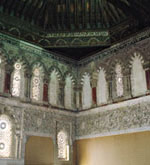 The synagogue features splendid examples of stucco relief with geometric-design patterns and interlaced floral elements as well as beautifully detailed Hebrew and Arabic inscriptions.The exterior walls, composed of mixed stone and brick typical of Muslim architecture in Spain, have aljima-type windows (consisting of a pair of horseshoe arches) above the entrance door. The synagogue features splendid examples of stucco relief with geometric-design patterns and interlaced floral elements as well as beautifully detailed Hebrew and Arabic inscriptions.The exterior walls, composed of mixed stone and brick typical of Muslim architecture in Spain, have aljima-type windows (consisting of a pair of horseshoe arches) above the entrance door. |
|
